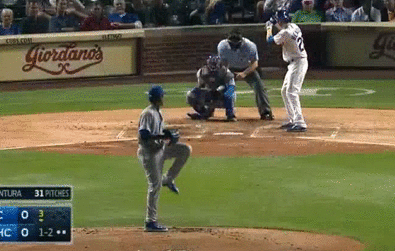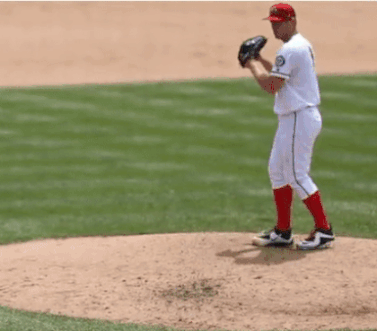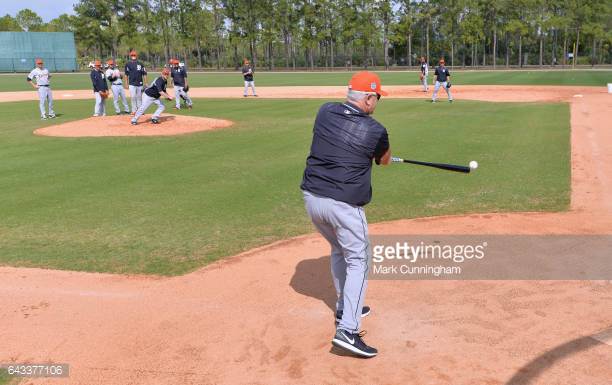No, Fielding Position Doesn’t Matter and PFPs Need to be Reconsidered
Every once in awhile a random thought pops into your head and makes you think “naw, that can’t be true…can it?”
The other day I caught a tweet about Justin Verlander’s fielding position on his 103rd pitch of the game. That deep into the game JV was still showing signs of high intent, dropping a 99 MPH fastball to freeze the hitter for a backwards K.

What sparked a particular line of thought for me was when Jarod Bayless satirically commented on the pitch that he “could use a better field position.”
It was obvious that Verlander was throwing the pitch with the intent to throw gas, as noticed by the heavy amount of lower half rotation into deceleration, the complete disregard for a fielding position and more obviously by his post game statement “I was really hoping to hit 100 there, but I didn’t quite get it.”
After seeing this tweet, I immediately thought to myself “I wonder how many times Justin Verlander actually fields a ball during the season. He clearly doesn’t care about being in a good fielding position.”
According to Fangraphs, in the 2016 season Justin Verlander made 7 putouts, had 29 assists and made no fielding errors. In his 34 games started, therefore, he had 36 total fielding plays — an average of roughly 1 play per game in 2016.
Looking at that stat on the surface, it seems reasonable to expect coaches to place importance on pitchers fielding their position. I mean you’d want them to be proficient if they have to make a play once a game.
But if you think about this with a little more depth, there are two questions that will surely pop up.
- Should we be coaching pitchers to finish their pitches in a readied fielding position?
- Will performing PFPs make a pitcher better at fielding their position?
If you read the title to this blog post then it should already be apparent what my answers are to these two questions.
Probably not.
Should we be coaching pitchers to finish their pitches in a readied fielding position?
Let’s take a motor control theory perspective on this one. If we follow the thought process that movement is shaped by intention, then why (or how) would we coach a player to both throw the ball at the target AND finish in a fielding position. Though it is possible to successfully pull off a dual intention movement, throwing strikes with high % effort while simultaneously asking a player to control for their end position seems rather difficult. The task of throwing strikes is hard enough as it is for every pitcher, let alone asking them to complete a separate and distinct task.
Moreover, if you are a pitcher throwing with high intent — then this secondary task of ending up in a fielding position may actually be a competing task. If you look at guys who throw with high intent you will see some extravagant follow throughs. As a result pitchers become more rotational, end up pointing towards first base or show off hilarious leg movements.


You can definitely say that none of these would classify as your ideal fielding position.
The idea that intent = velocity as a hard rule is a bit of a contentious claim. There are a number of examples of guys throwing high 90’s with what seems like a more controlled deceleration and great fielding position. This recent Blake Treinen gif comes to mind!
The fact of the matter is that intent does not always equal velocity and vice versa. There are exceptions to the rules.
Regardless of whether or not high ‘intent’ pitching interferes with ending up in a good fielding position, we should return back to the fielding statistics of Justin Verlander for a second.
In 2016, JV was involved in 36 fielding plays in 34 games. Broken down further, that is 36 plays in 3668 pitches! With every pitch that Verlander threw, there was roughly a 1% chance that he was going to make a fielding play. In other words, 99% of the time he didn’t need to be in fielding position.
Are there potentially batted balls that he couldn’t get to because he fell off to the left? Yes. Are there potentially more batted balls that he did get to because he fell off the left? Yes. Is there a signfiicant difference in batted balls that are playable if falling off to the side versus not falling off to the side. I am not sure, but I’d guess probably not. Even if there was, would that more likely bump 1% to 2% or 10%, 20%, 50%?
So whether or not high intent is necessary for velocity or equates to ending up turned towards first base, the chances of that even mattering for JV are 1%. If there’s even a small chance that forcing a pitcher to end in a good fielding position will decrease performance, then it’s not worth trying to correct.
Will performing PFPs make a pitcher better at fielding their position?
In short, the way most people take PFPs, no.
If we surveyed every high school and collegiate program, we’d find that the majority of pitchers practice PFPs in a similar matter. Line up on the mound, go through a dry mechanical rep, and react to and field a predictable softly hit ground ball from the hitting coach. Sometimes coaches get spicey and hit the ball a bit harder or randomly opposite to where they just hit it. Repeat for 15-20 minutes once a week while fielders do something important.
Sound about right?
Let’s break down some issues with this type of practice.
There is a mismatch between the perception-action coupling of the game and that seen in the drill. In a live game, pitchers throw the baseball to a real hitter, then have to make a millisecond movement decision that was not predictable (remember 1%), and also react to the variant in game dynamics of the play. The perceptual information (called affordances) that pitchers are using to make these decisions in a game just aren’t present in the drill. Things like where their body was when releasing the ball, the speed at which they’re moving, the ball’s flight path to the plate, the bat path in reaction to the ball’s location, the handedness of the batter among many others don’t show up in the standard PFP. Am I the only one who has never seen pitchers receive PFP practice from hitters of both handedness?

The affordances here are not the same as what’s encountered in game.
Lack of accounting for pressure. We know that pressure can induce negative movement changes or even result in a player choking. It’s been shown in the literature that players kinematics can freeze up or become rigid as a result of succumbing to pressure. By practicing in an environment devoid of significance or time constraints, we are creating solutions to movement tasks that are fragile and less resilient than if they were practiced in heightened stakes or emotional levels. If we only practice PFPs in a nonchalant manner can we really expect them to be executed in high speed and high stakes? The idea that we need to progressively expose players to pressure situations in order to improve their psychological capacity was detailed further here.
Pitchers need to be infielders… and train like them too. My belief is that asking pitchers to field their position requires them to literally be good fielders. They should have the ability to throw on the run, be accurate from awkward angles, flip balls with their gloves, and be able to properly execute the task ‘get baseball from my hand to a baseman accurately and quickly.’ If we really want to have good fielding pitchers then we need to expose them to many different task dynamics — in other words, shortstop practice for everyone! No seriously, I think pitchers should practice playing other infield positions. Not only does restricting a high school pitcher to PO status crush their ability as throwers (less task dynamics = less movement solutions = less flexible to variant in game demands on the mound) but it also stunts their fielding development.

You can’t practice this play specifically, but you can pratice being a more coordinated fielder…and monotonous, predictable PFPS are not the way to go.
These are just a few of the shortcomings of the standard PFP drill work that I see and there are likely many more.
*One counter argument is that PFP work is more than just fielding a ground ball, but also includes situational plays and position coverage. Yes, that is important to have nailed down, but do we really need to devote any significant time to this? At what age or experience level does positioning on the field become automatic? Or bunt coverage?
In Summary
I believe that if pitchers field 1% of the pitches thrown, then maximizing the effectiveness of each pitch should be their primary focus. If increased awareness of fielding your position is a detriment to this effectiveness, then we have a problem.
If we want pitchers to be better fielders then we need to reconsider the standard PFP. Pitchers should be great infielders before pitching fielders just as they should be great throwers before pitchers.
